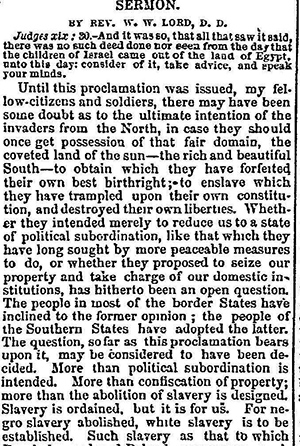Civil War Biblicism and the Demise of the Confederacy

The Georgian newspaper The Macon Daily Telegraph and Confederate published a New Revelation in the bleak fall of 1864, when the doom of the Confederate States of America seemed to draw closer by the day. The revelation, a pamphlet of 12 pages, was an extraordinary piece of American Old Testamentism that recast the central narratives of the Hebrew Bible as chronicles about America: North America, “the birthplace of mankind,” was sanctified, or rather Canaanized, and became the geographical center of the biblical drama: “the river that went out to water the garden of Eden…was the Mississippi-Pison, the river compassing the land of Havilah, the Arkansas; Gihon, the river lining the boundary of Ethiopia, is the Ohio. Hidekel, the Missouri, and Euphrates, the Upper Mississippi.” The New Revelation wholly conflated the biblical and American landscapes, with “the Hebrew Canaan [identified as] the United States, Mexico and Central America.” “Joshua,” the revelation’s author, could even identify “the site of the present city of New York” as the place where Noah built his ark and made preparation for his voyage. Another crucial moment in the Amero-biblical drama that the revelation narrated took place 5,000 years after the deluge, when “a weather-beaten vessel is seen, laden with the first Virginia colony.” When it lands, the sons of Abel—the Europeans, according to Joshua’s account—face the sons of Cain—the Indians—as they “swap beads for whisky.”
Click image to view full pdf
The original thirteen colonies in North America, the revelation continued, “were none other than a regeneration of the twelve tribes of Israel,” neatly corresponding to their biblical counterparts: North Carolina was Gad, South Carolina—Simeon, Dan was New York, Manasseh—Virginia, and so on, each colony “named after the corresponding territory in Israel.” At that point the author Joshua extended the liberty he took with interpreting the original narrative and described “the terrible conflict between Monarchy and Republicanism,” which apparently matched the American sectional conflict between the Union and the Confederacy. The discord ends with “the Jews’ return to Palestine with a free Government, the negroes to Africa, and a republican form of government extends from the western border of British America, half way round the globe,” throughout Europe. Only the progeny of Cain, incapable of any government, “dwell in the lands of his brothers.” These, the newspaper’s editor commented, must have been “the niggers and yankees.”[1]
Click image to view full pdf
Click image to view full pdf
Click image to view full pdf
Footnotes:
[1] “A New Revelation,” Macon Daily Telegraph and Confederate, Oct. 20, 1864.
[2] “God’s Rule in America a Subject of Thanksgiving,” Peninsular News and Advertiser [Delaware], Dec. 6, 1861: 1; “Jeroboam and Jeff. Davis,” The New York Herald, Jan. 31, 1861.
[3] “Status of the Rebellion,” Weekly Wisconsin Patriot, Mar. 15, 1862: 2; “Be Not Discouraged,” Macon Daily Telegraph, Feb. 13, 1862.
[4] For an impressive wartime restatement of the United States as the Second Israel see Phillips, The American Republic and Human Liberty Foreshadowed in Scripture.








